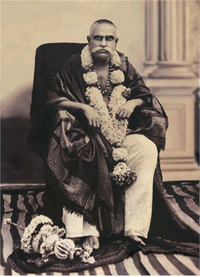|
C. V. Raman Pillai
Cannankara Velayudhan Raman Pillai (19 May 1858 – 21 March 1922), also known as C. V., was one of the major Indian novelists and playwrights and a pioneering playwright and novelist of Malayalam literature. He was known for his historical novels such as Marthandavarma, Dharmaraja and Ramaraja Bahadur; the last mentioned considered by many as one of the greatest novels written in Malayalam. Biography Born in Thiruvananthapuram (Trivandrum), capital city of the erstwhile native State of Travancore, on 19 May 1858 to Panavilakath Neelakanta Pillai, a Sanskrit scholar and Parvathy Pillai, a scion of an ancient matrilineal family; both his parents were from middle-class families and employees at the Palace of the Maharaja of Travancore.[1] Pillai got his family name, Cannankara, through matrilineal succession. Fondly called Ramu, he had a traditional Sanskritized education, early in life, under his father's tutelage which included lessons in Ayurveda and even magic and Tantra. He continued education at the first English school in Thiruvananthapuram. Subsequently, he graduated from His Highness Maharaja's College (the present-day University College Thiruvananthapuram), the first-ever College in Travancore,[2] where he reportedly had a brilliant academic career under John Ross, the principal of the institution and Robert Harvey. and obtained his BA degree from the Madras University in 1881, securing the 7th rank in the Madras Presidency. It was during this period, he started his first periodical named The Kerala Patriot.[3] After graduation, Pillai studied law but dropped out and went to Madras to study for the government pleader examination which was also abandoned in due course.[1] Later, he joined the High Court as a clerk and where he rose to the position of a shirasthadar. Later, joined the Government Press and held the position of a superintendent when he retired from service.[1] In between, he founded three publications, Malayali in 1886, Vanchiraj in 1901 and Mitabhashi in 1920.[3] Pillai's first marriage did not last long. He married again in 1887 at the age of 30, and his wife, Bhageerathi Amma, was only 16 at the time of the wedding. The marriage lasted till his wife's untimely death in 1904 and his third marriage was to Janaki Amma, the elder sister of Bhageerathi Amma and the widow of C. Raja Raja Varma, the younger brother of Raja Ravi Varma. He died on 21 March 1922, at the age of 63, survived by Janaki Amma.[1] Writing career Raman Pillai is compared by many with Bankim Chandra Chatterjee in Bengali and Hari Narayan Apte in Marathi, two other greats of India literature.[3] His first published book was Chandramukhivilasam, a satire.[3] He wrote his first novel, Marthandavarma, in 1885 but it was published in 1891.[4] This followed sch historical novels as Dharmaraja and Ramarajabahadur, the social novel, Premamritam[5] as well as several farces. Modern Malayalam drama traces its origins to his works. He is credited with the first original play in Malayalam, Chandramukheevilasam, written in 1884 and was staged for four days successively in 1887 at His Highness Maharaja's College, Trivandrum.[1] Exegetic dictionaryC. V. Vyaakhyaana Kosham[6] is a 400-plus page lexicographic work in four volumes, based on Pillai's books. The work includes the explanations, elucidations and interpretations of over 700,000 Malayalam, Sanskrit, Tamil, Hindustani and English words used by him in his writings.[7][8] WorksNovelsHistorical novels
Social novels
Uncategorized
Plays
Other works
As editor in newspapers
TranslationsHonoursThe India Post issued a commemorative postage stamp on Pillai on 19 May 2010.[15][16] A road in Vazhuthacaud, Thiruvananthapuram has been neamed after him as C. V. Raman Pillai Road.[17] Chenkal, a panchayat in Thiruvananthapuram which includes his native village of Arayoor, was renamed as C.V.R. Puram in 1970.[18][19] Writings on Raman Pillai
See alsoOther social reformers of Kerala
References
External links
Wikimedia Commons has media related to C. V. Raman Pillai. |
||||||||||||||||||||||||||||
